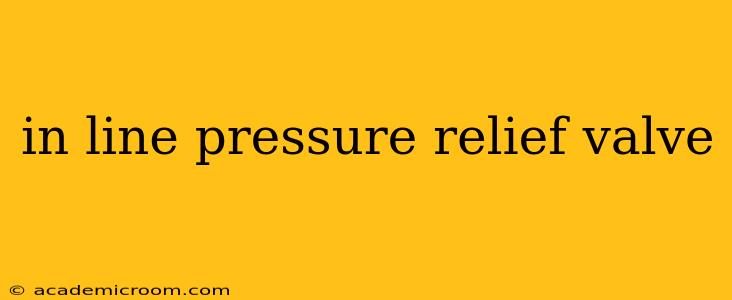In-line pressure relief valves are crucial safety devices found in various hydraulic and pneumatic systems. They prevent excessive pressure buildup, protecting components from damage and ensuring system integrity. Understanding their function, selection, and maintenance is vital for safe and efficient operation. This comprehensive guide delves into the intricacies of in-line pressure relief valves, addressing common questions and providing valuable insights for both professionals and enthusiasts.
What is an In-Line Pressure Relief Valve?
An in-line pressure relief valve, also known as a pressure relief valve or pressure safety valve, is a safety device installed directly in a fluid line. When the system pressure exceeds a predetermined setpoint, the valve opens, allowing excess fluid to bypass the main system, thus preventing pressure from rising to dangerously high levels. This protects sensitive components like pumps, actuators, and piping from damage caused by overpressure. They are typically spring-loaded, with the spring tension dictating the pressure at which the valve opens.
How Does an In-Line Pressure Relief Valve Work?
The operation is relatively straightforward. Fluid flows through the valve under normal operating pressure. When the system pressure increases beyond the setpoint, the pressure overcomes the force of the spring, causing a poppet or diaphragm to lift, opening a bypass path. The excess fluid is then diverted, relieving the pressure within the system. Once the pressure drops below the setpoint, the spring force closes the valve, resuming normal operation.
What are the Different Types of In-Line Pressure Relief Valves?
Several types of in-line pressure relief valves exist, each designed for specific applications and pressure ranges:
-
Spring-Loaded Valves: These are the most common type, utilizing a spring to control the opening pressure. They are relatively simple, reliable, and cost-effective.
-
Pilot-Operated Valves: These valves use a small pilot pressure signal to control the opening and closing of the main valve. This allows for more precise pressure control and faster response times.
-
Direct-Acting Valves: These valves directly respond to the system pressure without any pilot signal. They are simpler in design than pilot-operated valves.
What are the Key Considerations When Selecting an In-Line Pressure Relief Valve?
Choosing the right in-line pressure relief valve is crucial for system safety and efficiency. Key considerations include:
-
Maximum Working Pressure: Ensure the valve's maximum working pressure rating exceeds the system's maximum anticipated pressure.
-
Set Pressure: The valve's set pressure should be carefully selected to provide adequate protection without unnecessarily venting fluid.
-
Flow Capacity: The valve must have sufficient flow capacity to handle the volume of fluid that needs to be bypassed when it opens.
-
Fluid Compatibility: The valve material should be compatible with the fluid being used in the system to prevent corrosion or degradation.
-
Connection Type: The valve's connection type (e.g., threaded, flanged) should match the system's piping.
How Often Should an In-Line Pressure Relief Valve be Inspected and Maintained?
Regular inspection and maintenance are essential for ensuring the reliable operation of in-line pressure relief valves. The frequency of inspection depends on the application and the manufacturer's recommendations, but it's generally advisable to inspect the valve at least annually. Maintenance might involve cleaning, lubrication, or spring adjustment, as needed. A qualified technician should perform any significant maintenance or repair.
What Happens if an In-Line Pressure Relief Valve Fails?
Failure of an in-line pressure relief valve can have serious consequences. If the valve fails to open when pressure exceeds the setpoint, catastrophic system failure could occur, leading to damage to components, equipment downtime, and potentially injury or property damage. Conversely, if the valve leaks or malfunctions in the open position, it can lead to fluid loss and system pressure drops. Regular inspections and maintenance are crucial to prevent such failures.
Can I Repair an In-Line Pressure Relief Valve Myself?
Repairing an in-line pressure relief valve is generally not recommended unless you have the necessary expertise and specialized tools. These valves are precision instruments, and improper repair can compromise their safety and effectiveness. Always refer to the manufacturer's instructions, and if you're unsure, consult a qualified technician.
What are the Common Causes of In-Line Pressure Relief Valve Failure?
Common causes of in-line pressure relief valve failure include:
-
Corrosion: Exposure to corrosive fluids can damage the valve's internal components.
-
Wear and Tear: Repeated cycles of opening and closing can cause wear and tear on the valve's seals and internal parts.
-
Contamination: Dirt, debris, or other contaminants can impede the valve's operation.
-
Improper Installation: Incorrect installation can lead to premature valve failure.
This guide provides a comprehensive overview of in-line pressure relief valves. Remember, always prioritize safety and consult with qualified professionals when working with high-pressure systems.
